Foundations of Nursing: Effective Clinical Handover Report
VerifiedAdded on 2020/02/23
|7
|1651
|60
Report
AI Summary
This report focuses on the essential aspects of clinical handover in nursing, emphasizing the nurses' responsibilities in ensuring safe and effective patient care. It explores the significance of structured communication, particularly the use of tools like ISBAR (Identify, Situation, Background, Assessment, Recommendation) to facilitate the transfer of critical patient information. The report highlights the importance of standardized processes, timely handovers, and appropriate documentation to minimize risks and enhance patient safety. It also addresses the application of change management principles, such as Kotter's eight steps, to implement and improve handover practices. Furthermore, the report underscores the role of nurses in continuous evaluation, collaboration with healthcare teams, and adaptation to organizational policies and procedures to optimize patient outcomes. It also discusses various handover methods, including face-to-face and bedside handovers, and provides insights on how nurses can promote effective communication and emotional support during the handover process. The report concludes by stressing the need for nurses to learn and develop their skills in collaboration with mentors, leaders, peers, and clinicians, recognizing handover as a vital component of patient care.
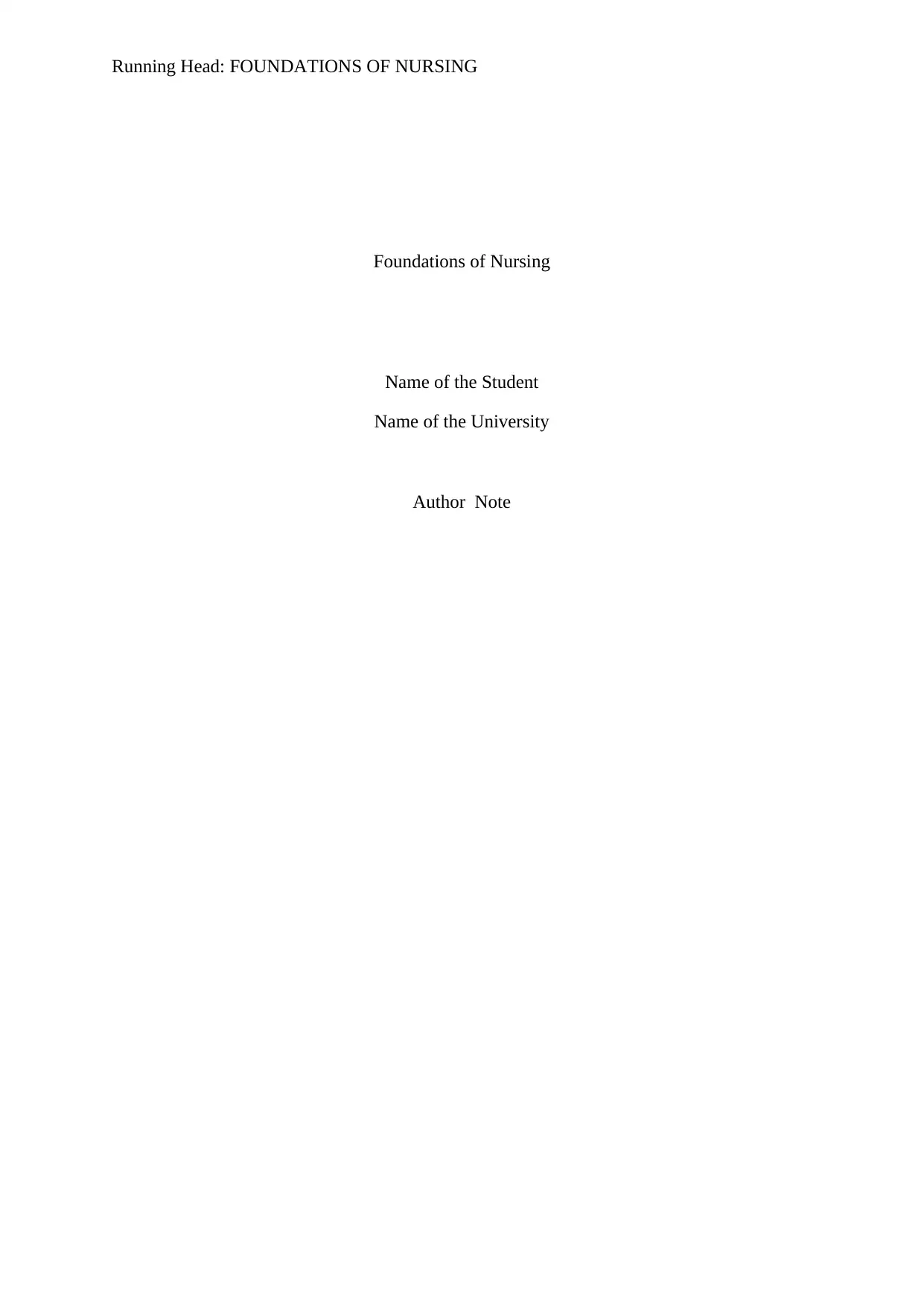
Running Head: FOUNDATIONS OF NURSING
Foundations of Nursing
Name of the Student
Name of the University
Author Note
Foundations of Nursing
Name of the Student
Name of the University
Author Note
Paraphrase This Document
Need a fresh take? Get an instant paraphrase of this document with our AI Paraphraser
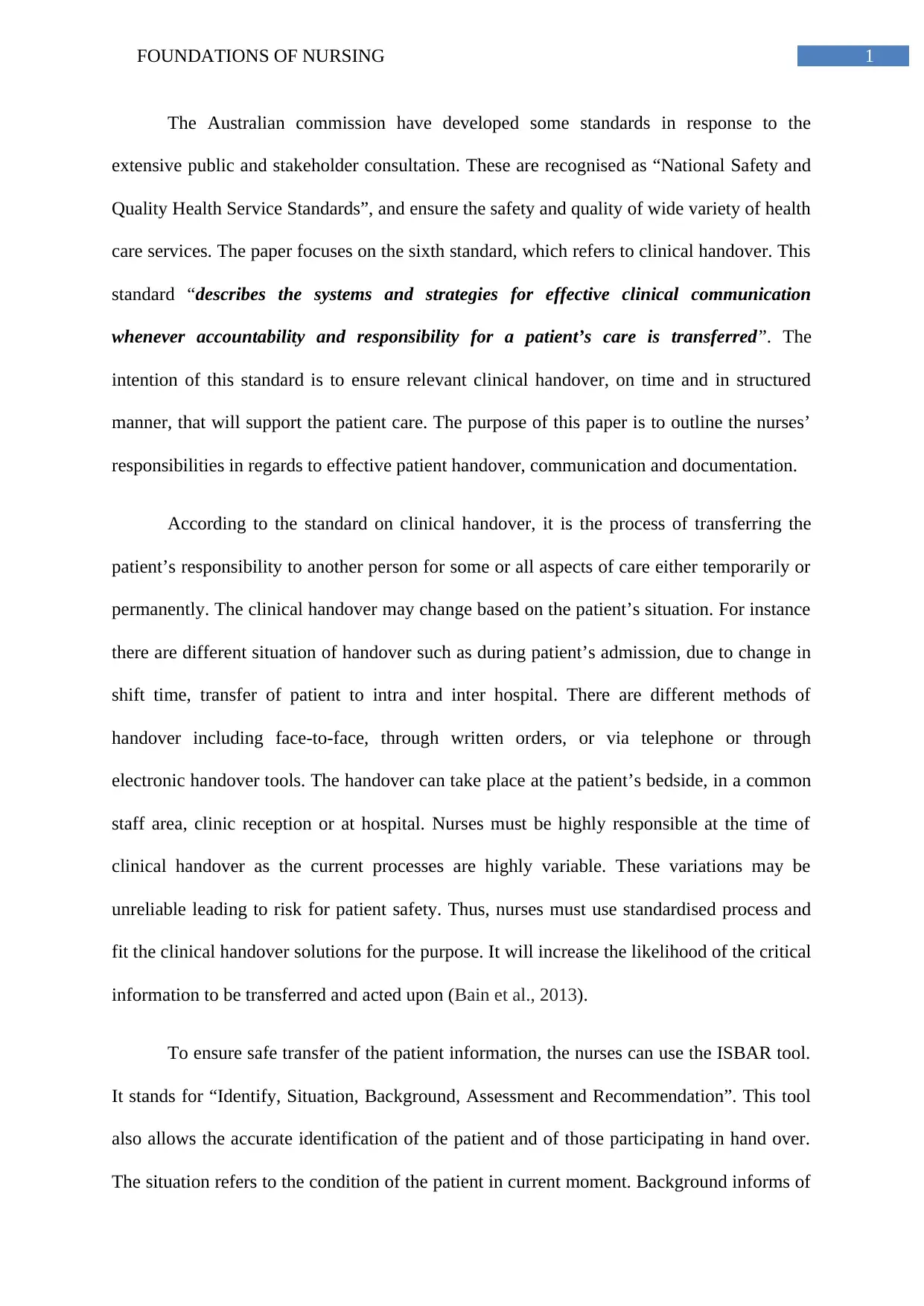
1FOUNDATIONS OF NURSING
The Australian commission have developed some standards in response to the
extensive public and stakeholder consultation. These are recognised as “National Safety and
Quality Health Service Standards”, and ensure the safety and quality of wide variety of health
care services. The paper focuses on the sixth standard, which refers to clinical handover. This
standard “describes the systems and strategies for effective clinical communication
whenever accountability and responsibility for a patient’s care is transferred”. The
intention of this standard is to ensure relevant clinical handover, on time and in structured
manner, that will support the patient care. The purpose of this paper is to outline the nurses’
responsibilities in regards to effective patient handover, communication and documentation.
According to the standard on clinical handover, it is the process of transferring the
patient’s responsibility to another person for some or all aspects of care either temporarily or
permanently. The clinical handover may change based on the patient’s situation. For instance
there are different situation of handover such as during patient’s admission, due to change in
shift time, transfer of patient to intra and inter hospital. There are different methods of
handover including face-to-face, through written orders, or via telephone or through
electronic handover tools. The handover can take place at the patient’s bedside, in a common
staff area, clinic reception or at hospital. Nurses must be highly responsible at the time of
clinical handover as the current processes are highly variable. These variations may be
unreliable leading to risk for patient safety. Thus, nurses must use standardised process and
fit the clinical handover solutions for the purpose. It will increase the likelihood of the critical
information to be transferred and acted upon (Bain et al., 2013).
To ensure safe transfer of the patient information, the nurses can use the ISBAR tool.
It stands for “Identify, Situation, Background, Assessment and Recommendation”. This tool
also allows the accurate identification of the patient and of those participating in hand over.
The situation refers to the condition of the patient in current moment. Background informs of
The Australian commission have developed some standards in response to the
extensive public and stakeholder consultation. These are recognised as “National Safety and
Quality Health Service Standards”, and ensure the safety and quality of wide variety of health
care services. The paper focuses on the sixth standard, which refers to clinical handover. This
standard “describes the systems and strategies for effective clinical communication
whenever accountability and responsibility for a patient’s care is transferred”. The
intention of this standard is to ensure relevant clinical handover, on time and in structured
manner, that will support the patient care. The purpose of this paper is to outline the nurses’
responsibilities in regards to effective patient handover, communication and documentation.
According to the standard on clinical handover, it is the process of transferring the
patient’s responsibility to another person for some or all aspects of care either temporarily or
permanently. The clinical handover may change based on the patient’s situation. For instance
there are different situation of handover such as during patient’s admission, due to change in
shift time, transfer of patient to intra and inter hospital. There are different methods of
handover including face-to-face, through written orders, or via telephone or through
electronic handover tools. The handover can take place at the patient’s bedside, in a common
staff area, clinic reception or at hospital. Nurses must be highly responsible at the time of
clinical handover as the current processes are highly variable. These variations may be
unreliable leading to risk for patient safety. Thus, nurses must use standardised process and
fit the clinical handover solutions for the purpose. It will increase the likelihood of the critical
information to be transferred and acted upon (Bain et al., 2013).
To ensure safe transfer of the patient information, the nurses can use the ISBAR tool.
It stands for “Identify, Situation, Background, Assessment and Recommendation”. This tool
also allows the accurate identification of the patient and of those participating in hand over.
The situation refers to the condition of the patient in current moment. Background informs of
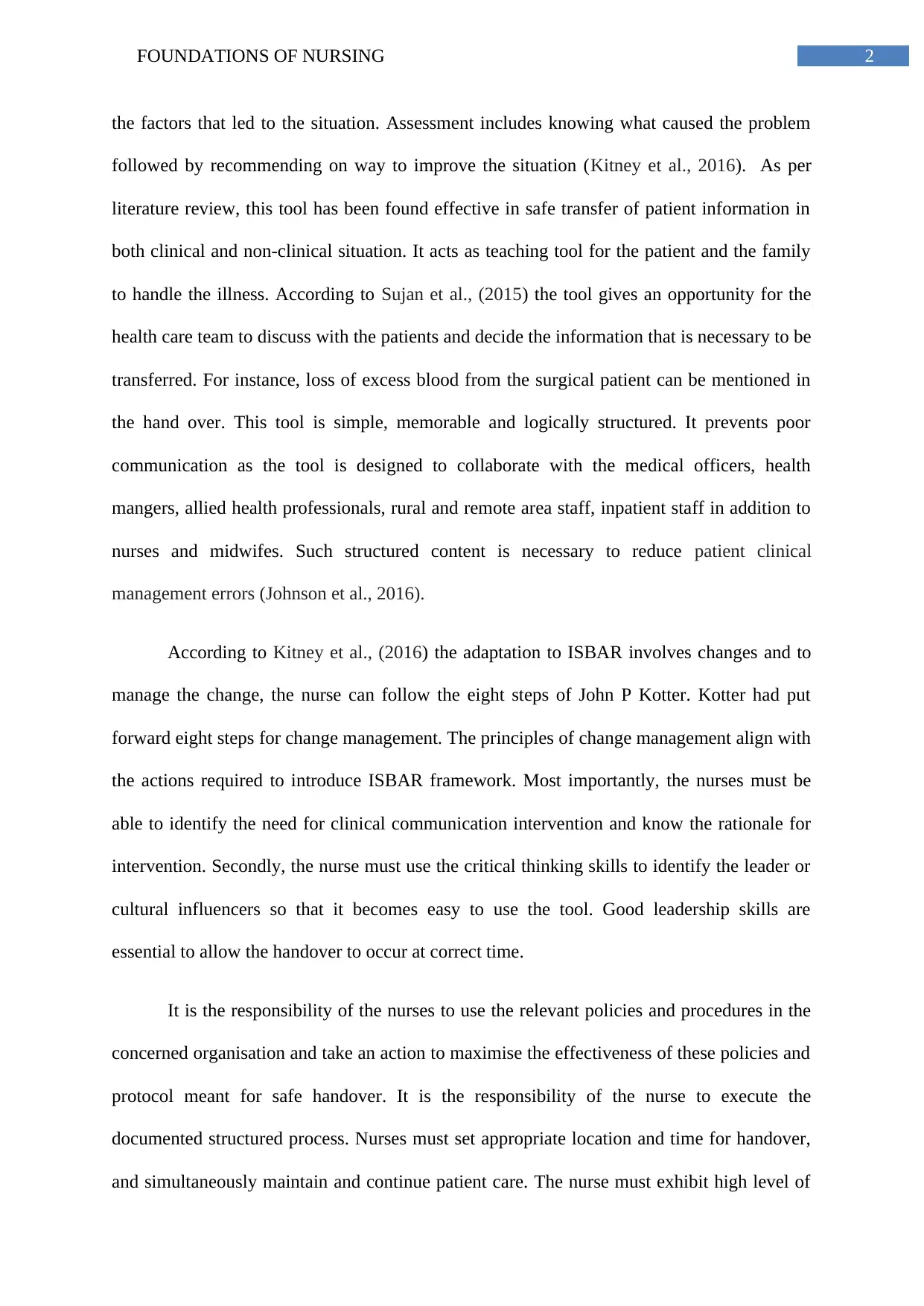
2FOUNDATIONS OF NURSING
the factors that led to the situation. Assessment includes knowing what caused the problem
followed by recommending on way to improve the situation (Kitney et al., 2016). As per
literature review, this tool has been found effective in safe transfer of patient information in
both clinical and non-clinical situation. It acts as teaching tool for the patient and the family
to handle the illness. According to Sujan et al., (2015) the tool gives an opportunity for the
health care team to discuss with the patients and decide the information that is necessary to be
transferred. For instance, loss of excess blood from the surgical patient can be mentioned in
the hand over. This tool is simple, memorable and logically structured. It prevents poor
communication as the tool is designed to collaborate with the medical officers, health
mangers, allied health professionals, rural and remote area staff, inpatient staff in addition to
nurses and midwifes. Such structured content is necessary to reduce patient clinical
management errors (Johnson et al., 2016).
According to Kitney et al., (2016) the adaptation to ISBAR involves changes and to
manage the change, the nurse can follow the eight steps of John P Kotter. Kotter had put
forward eight steps for change management. The principles of change management align with
the actions required to introduce ISBAR framework. Most importantly, the nurses must be
able to identify the need for clinical communication intervention and know the rationale for
intervention. Secondly, the nurse must use the critical thinking skills to identify the leader or
cultural influencers so that it becomes easy to use the tool. Good leadership skills are
essential to allow the handover to occur at correct time.
It is the responsibility of the nurses to use the relevant policies and procedures in the
concerned organisation and take an action to maximise the effectiveness of these policies and
protocol meant for safe handover. It is the responsibility of the nurse to execute the
documented structured process. Nurses must set appropriate location and time for handover,
and simultaneously maintain and continue patient care. The nurse must exhibit high level of
the factors that led to the situation. Assessment includes knowing what caused the problem
followed by recommending on way to improve the situation (Kitney et al., 2016). As per
literature review, this tool has been found effective in safe transfer of patient information in
both clinical and non-clinical situation. It acts as teaching tool for the patient and the family
to handle the illness. According to Sujan et al., (2015) the tool gives an opportunity for the
health care team to discuss with the patients and decide the information that is necessary to be
transferred. For instance, loss of excess blood from the surgical patient can be mentioned in
the hand over. This tool is simple, memorable and logically structured. It prevents poor
communication as the tool is designed to collaborate with the medical officers, health
mangers, allied health professionals, rural and remote area staff, inpatient staff in addition to
nurses and midwifes. Such structured content is necessary to reduce patient clinical
management errors (Johnson et al., 2016).
According to Kitney et al., (2016) the adaptation to ISBAR involves changes and to
manage the change, the nurse can follow the eight steps of John P Kotter. Kotter had put
forward eight steps for change management. The principles of change management align with
the actions required to introduce ISBAR framework. Most importantly, the nurses must be
able to identify the need for clinical communication intervention and know the rationale for
intervention. Secondly, the nurse must use the critical thinking skills to identify the leader or
cultural influencers so that it becomes easy to use the tool. Good leadership skills are
essential to allow the handover to occur at correct time.
It is the responsibility of the nurses to use the relevant policies and procedures in the
concerned organisation and take an action to maximise the effectiveness of these policies and
protocol meant for safe handover. It is the responsibility of the nurse to execute the
documented structured process. Nurses must set appropriate location and time for handover,
and simultaneously maintain and continue patient care. The nurse must exhibit high level of
⊘ This is a preview!⊘
Do you want full access?
Subscribe today to unlock all pages.

Trusted by 1+ million students worldwide
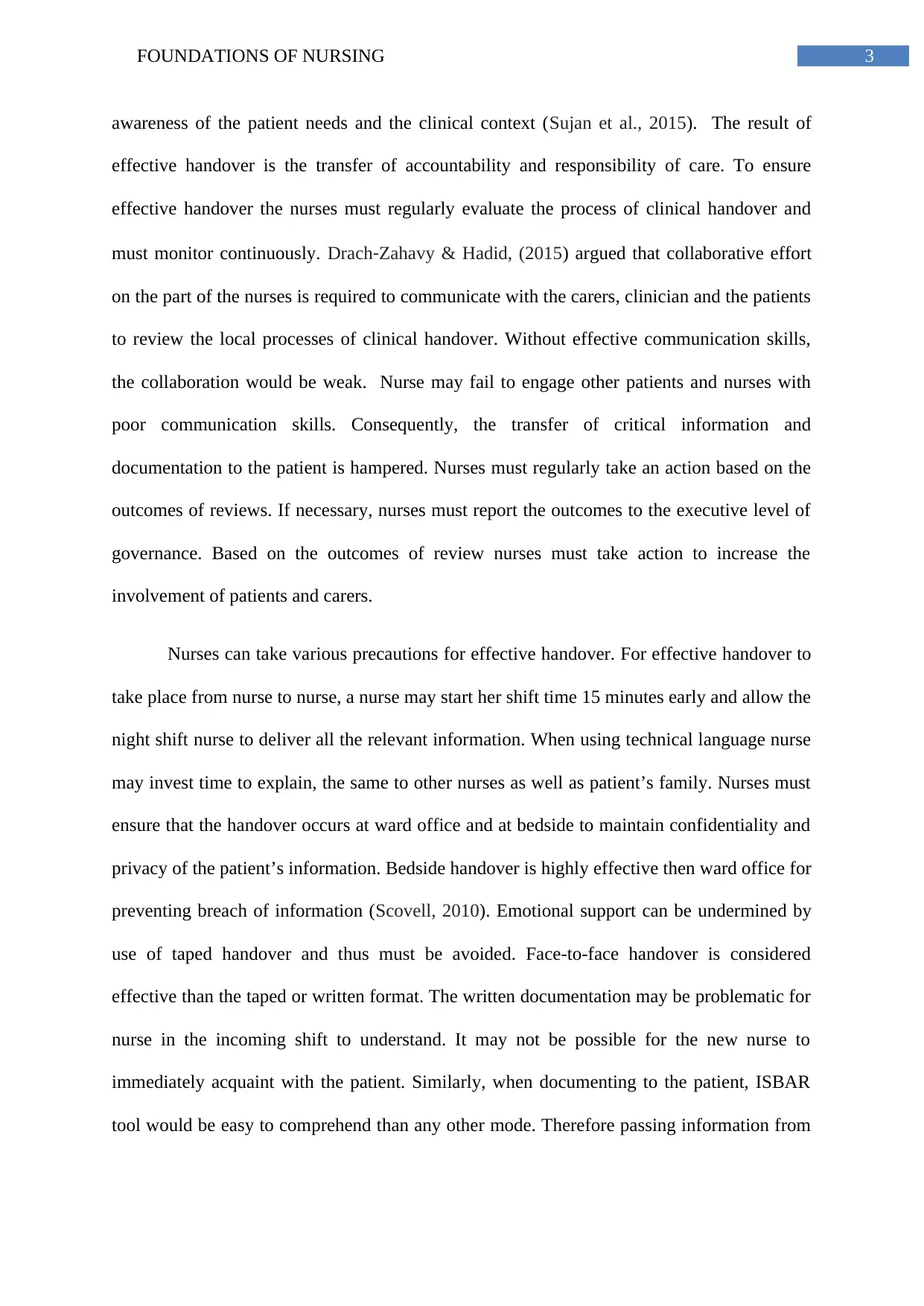
3FOUNDATIONS OF NURSING
awareness of the patient needs and the clinical context (Sujan et al., 2015). The result of
effective handover is the transfer of accountability and responsibility of care. To ensure
effective handover the nurses must regularly evaluate the process of clinical handover and
must monitor continuously. Drach‐Zahavy & Hadid, (2015) argued that collaborative effort
on the part of the nurses is required to communicate with the carers, clinician and the patients
to review the local processes of clinical handover. Without effective communication skills,
the collaboration would be weak. Nurse may fail to engage other patients and nurses with
poor communication skills. Consequently, the transfer of critical information and
documentation to the patient is hampered. Nurses must regularly take an action based on the
outcomes of reviews. If necessary, nurses must report the outcomes to the executive level of
governance. Based on the outcomes of review nurses must take action to increase the
involvement of patients and carers.
Nurses can take various precautions for effective handover. For effective handover to
take place from nurse to nurse, a nurse may start her shift time 15 minutes early and allow the
night shift nurse to deliver all the relevant information. When using technical language nurse
may invest time to explain, the same to other nurses as well as patient’s family. Nurses must
ensure that the handover occurs at ward office and at bedside to maintain confidentiality and
privacy of the patient’s information. Bedside handover is highly effective then ward office for
preventing breach of information (Scovell, 2010). Emotional support can be undermined by
use of taped handover and thus must be avoided. Face-to-face handover is considered
effective than the taped or written format. The written documentation may be problematic for
nurse in the incoming shift to understand. It may not be possible for the new nurse to
immediately acquaint with the patient. Similarly, when documenting to the patient, ISBAR
tool would be easy to comprehend than any other mode. Therefore passing information from
awareness of the patient needs and the clinical context (Sujan et al., 2015). The result of
effective handover is the transfer of accountability and responsibility of care. To ensure
effective handover the nurses must regularly evaluate the process of clinical handover and
must monitor continuously. Drach‐Zahavy & Hadid, (2015) argued that collaborative effort
on the part of the nurses is required to communicate with the carers, clinician and the patients
to review the local processes of clinical handover. Without effective communication skills,
the collaboration would be weak. Nurse may fail to engage other patients and nurses with
poor communication skills. Consequently, the transfer of critical information and
documentation to the patient is hampered. Nurses must regularly take an action based on the
outcomes of reviews. If necessary, nurses must report the outcomes to the executive level of
governance. Based on the outcomes of review nurses must take action to increase the
involvement of patients and carers.
Nurses can take various precautions for effective handover. For effective handover to
take place from nurse to nurse, a nurse may start her shift time 15 minutes early and allow the
night shift nurse to deliver all the relevant information. When using technical language nurse
may invest time to explain, the same to other nurses as well as patient’s family. Nurses must
ensure that the handover occurs at ward office and at bedside to maintain confidentiality and
privacy of the patient’s information. Bedside handover is highly effective then ward office for
preventing breach of information (Scovell, 2010). Emotional support can be undermined by
use of taped handover and thus must be avoided. Face-to-face handover is considered
effective than the taped or written format. The written documentation may be problematic for
nurse in the incoming shift to understand. It may not be possible for the new nurse to
immediately acquaint with the patient. Similarly, when documenting to the patient, ISBAR
tool would be easy to comprehend than any other mode. Therefore passing information from
Paraphrase This Document
Need a fresh take? Get an instant paraphrase of this document with our AI Paraphraser
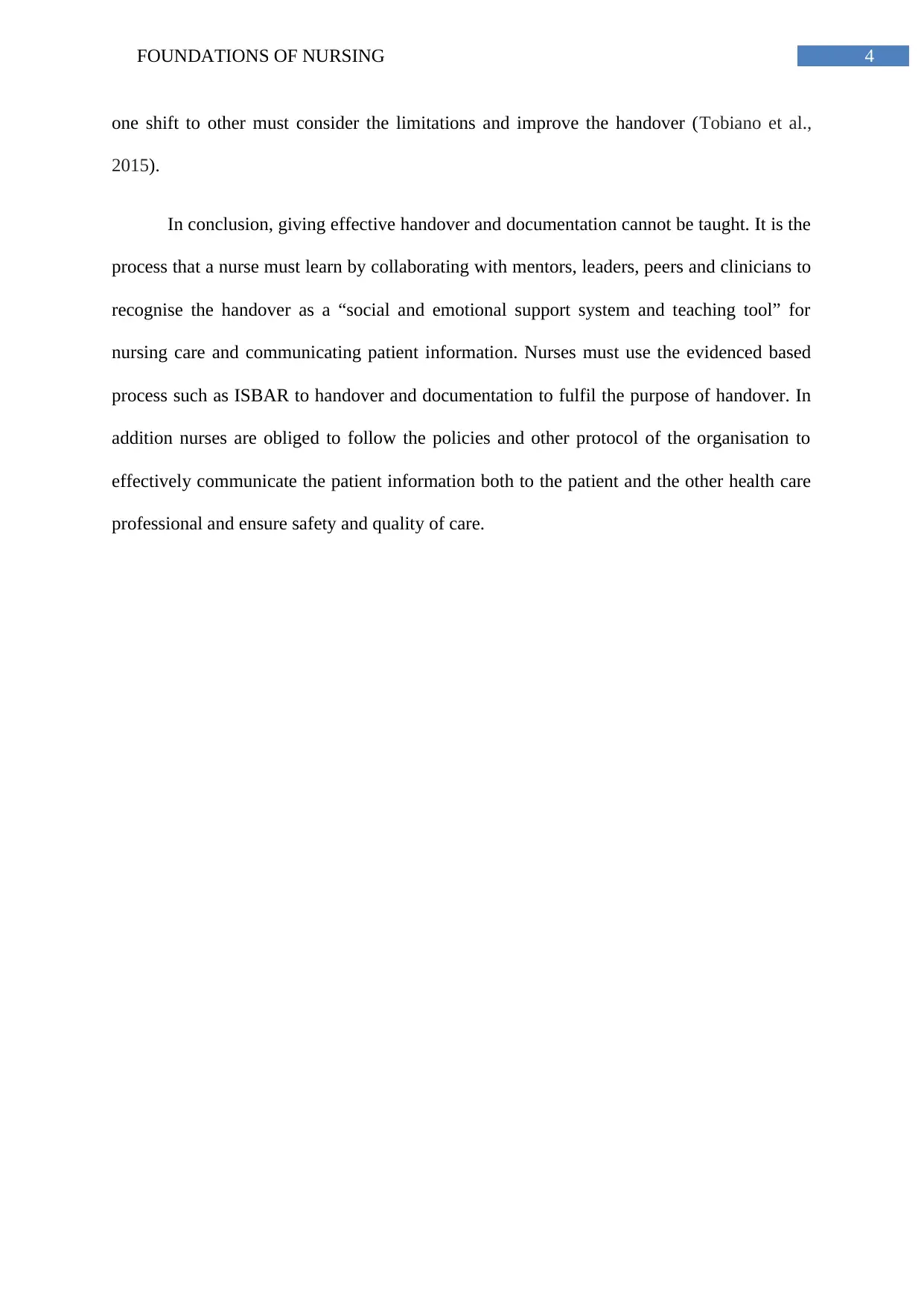
4FOUNDATIONS OF NURSING
one shift to other must consider the limitations and improve the handover (Tobiano et al.,
2015).
In conclusion, giving effective handover and documentation cannot be taught. It is the
process that a nurse must learn by collaborating with mentors, leaders, peers and clinicians to
recognise the handover as a “social and emotional support system and teaching tool” for
nursing care and communicating patient information. Nurses must use the evidenced based
process such as ISBAR to handover and documentation to fulfil the purpose of handover. In
addition nurses are obliged to follow the policies and other protocol of the organisation to
effectively communicate the patient information both to the patient and the other health care
professional and ensure safety and quality of care.
one shift to other must consider the limitations and improve the handover (Tobiano et al.,
2015).
In conclusion, giving effective handover and documentation cannot be taught. It is the
process that a nurse must learn by collaborating with mentors, leaders, peers and clinicians to
recognise the handover as a “social and emotional support system and teaching tool” for
nursing care and communicating patient information. Nurses must use the evidenced based
process such as ISBAR to handover and documentation to fulfil the purpose of handover. In
addition nurses are obliged to follow the policies and other protocol of the organisation to
effectively communicate the patient information both to the patient and the other health care
professional and ensure safety and quality of care.
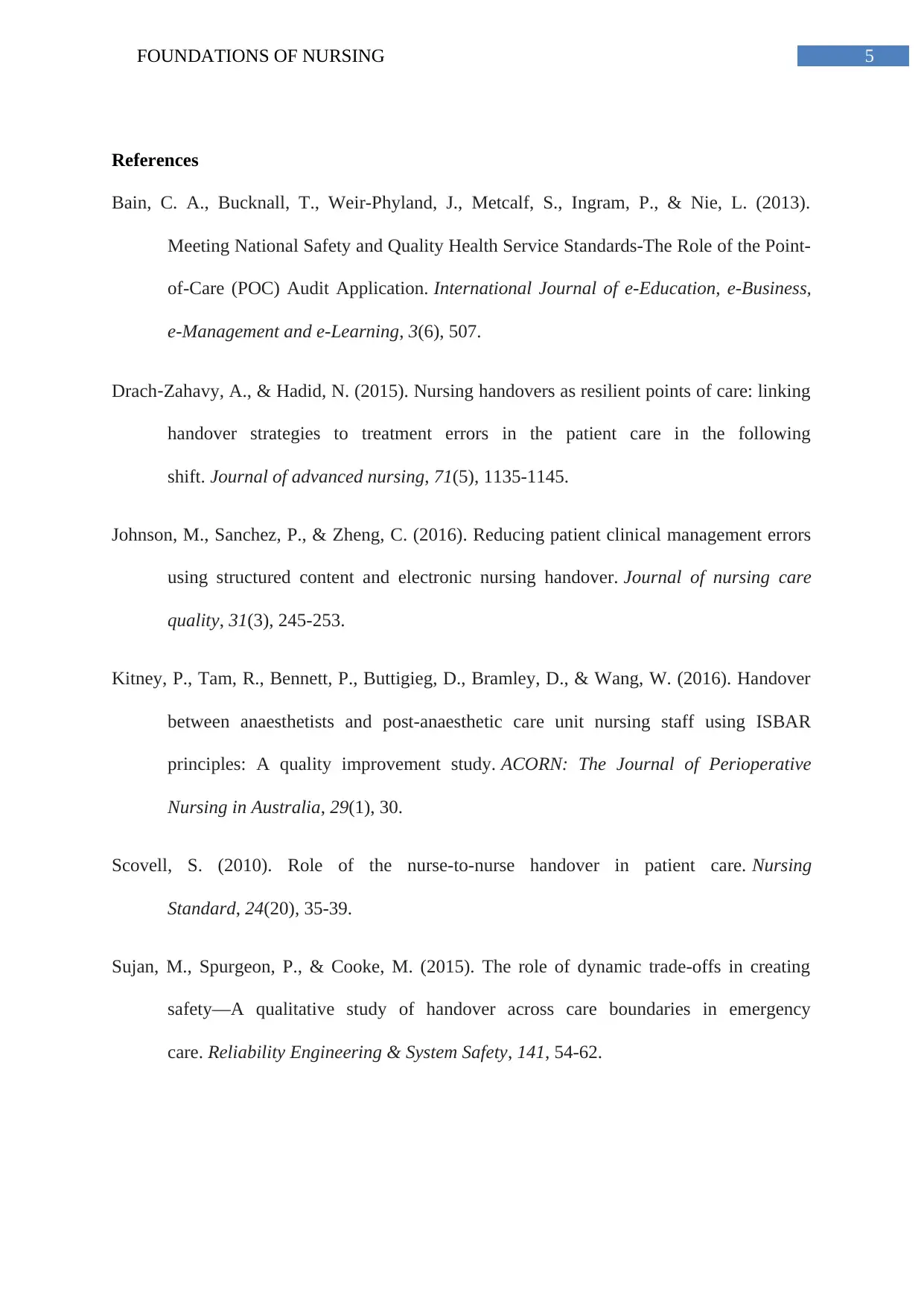
5FOUNDATIONS OF NURSING
References
Bain, C. A., Bucknall, T., Weir-Phyland, J., Metcalf, S., Ingram, P., & Nie, L. (2013).
Meeting National Safety and Quality Health Service Standards-The Role of the Point-
of-Care (POC) Audit Application. International Journal of e-Education, e-Business,
e-Management and e-Learning, 3(6), 507.
Drach‐Zahavy, A., & Hadid, N. (2015). Nursing handovers as resilient points of care: linking
handover strategies to treatment errors in the patient care in the following
shift. Journal of advanced nursing, 71(5), 1135-1145.
Johnson, M., Sanchez, P., & Zheng, C. (2016). Reducing patient clinical management errors
using structured content and electronic nursing handover. Journal of nursing care
quality, 31(3), 245-253.
Kitney, P., Tam, R., Bennett, P., Buttigieg, D., Bramley, D., & Wang, W. (2016). Handover
between anaesthetists and post-anaesthetic care unit nursing staff using ISBAR
principles: A quality improvement study. ACORN: The Journal of Perioperative
Nursing in Australia, 29(1), 30.
Scovell, S. (2010). Role of the nurse-to-nurse handover in patient care. Nursing
Standard, 24(20), 35-39.
Sujan, M., Spurgeon, P., & Cooke, M. (2015). The role of dynamic trade-offs in creating
safety—A qualitative study of handover across care boundaries in emergency
care. Reliability Engineering & System Safety, 141, 54-62.
References
Bain, C. A., Bucknall, T., Weir-Phyland, J., Metcalf, S., Ingram, P., & Nie, L. (2013).
Meeting National Safety and Quality Health Service Standards-The Role of the Point-
of-Care (POC) Audit Application. International Journal of e-Education, e-Business,
e-Management and e-Learning, 3(6), 507.
Drach‐Zahavy, A., & Hadid, N. (2015). Nursing handovers as resilient points of care: linking
handover strategies to treatment errors in the patient care in the following
shift. Journal of advanced nursing, 71(5), 1135-1145.
Johnson, M., Sanchez, P., & Zheng, C. (2016). Reducing patient clinical management errors
using structured content and electronic nursing handover. Journal of nursing care
quality, 31(3), 245-253.
Kitney, P., Tam, R., Bennett, P., Buttigieg, D., Bramley, D., & Wang, W. (2016). Handover
between anaesthetists and post-anaesthetic care unit nursing staff using ISBAR
principles: A quality improvement study. ACORN: The Journal of Perioperative
Nursing in Australia, 29(1), 30.
Scovell, S. (2010). Role of the nurse-to-nurse handover in patient care. Nursing
Standard, 24(20), 35-39.
Sujan, M., Spurgeon, P., & Cooke, M. (2015). The role of dynamic trade-offs in creating
safety—A qualitative study of handover across care boundaries in emergency
care. Reliability Engineering & System Safety, 141, 54-62.
⊘ This is a preview!⊘
Do you want full access?
Subscribe today to unlock all pages.

Trusted by 1+ million students worldwide
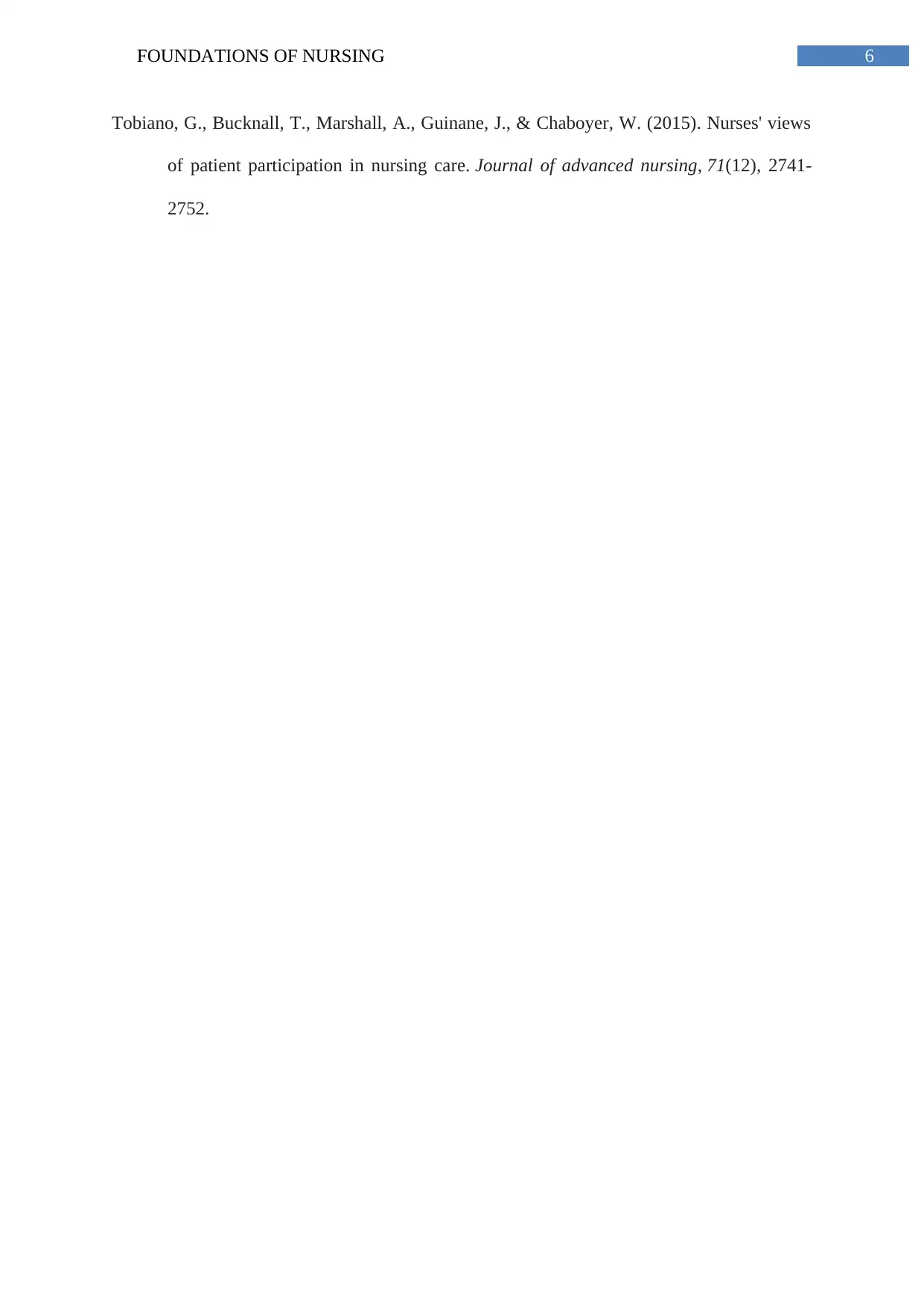
6FOUNDATIONS OF NURSING
Tobiano, G., Bucknall, T., Marshall, A., Guinane, J., & Chaboyer, W. (2015). Nurses' views
of patient participation in nursing care. Journal of advanced nursing, 71(12), 2741-
2752.
Tobiano, G., Bucknall, T., Marshall, A., Guinane, J., & Chaboyer, W. (2015). Nurses' views
of patient participation in nursing care. Journal of advanced nursing, 71(12), 2741-
2752.
1 out of 7
Related Documents
Your All-in-One AI-Powered Toolkit for Academic Success.
+13062052269
info@desklib.com
Available 24*7 on WhatsApp / Email
![[object Object]](/_next/static/media/star-bottom.7253800d.svg)
Unlock your academic potential
Copyright © 2020–2025 A2Z Services. All Rights Reserved. Developed and managed by ZUCOL.




